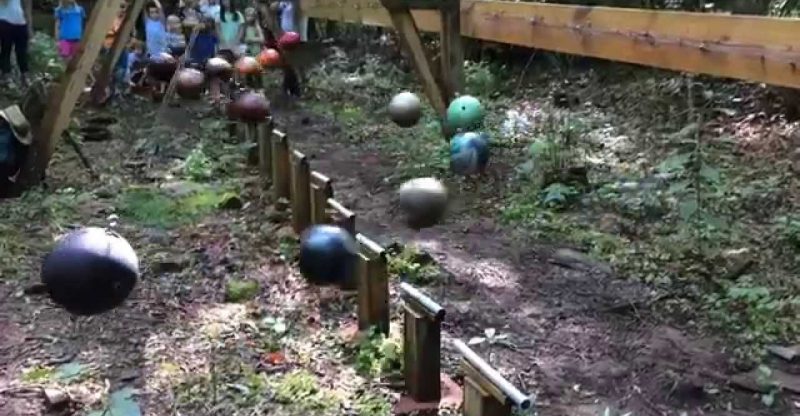Pendulum Wave Demonstration
This is a large-scale demonstration of the interaction between period and pendulum length, using 16 bowling balls hung from a wooden frame.
Here are answers to some common questions:
** What am I seeing? How does this work? **
The length of time it takes a ball to swing back and forth one time to return to its starting position is dependent on the length of the pendulum, not the mass of the ball. A longer pendulum will take longer to complete one cycle than a shorter pendulum. The lengths of the pendula in this demonstration are all different and were calculated so that in about 2:40, the balls all return to the same position at the same time – in that 2:40, the longest pendulum (in front) will oscillate (or go back and forth) 50 times, the next will oscillate 51 times, and on to the last of the 16 pendula which will oscillate 65 times. Try counting how many times the ball in front swings back and forth in the time it takes the balls to line up again, and then count how many times the ball in back swings back and forth in the same time (though it’s much harder to keep your eye on the ball in back!)
** Who made this? **
This was made by Jeff Goodman, who teaches at Appalachian State University in Boone, NC. Jeff has some more information and videos about the making of this pendulum wave at http://celophoto.blogspot.com/2012/03/last-bowling-ball-pendulum-post-i.html
** Why are they not perfect at the end? **
This large frame is built from wood and is outdoors, which means it expands, contracts, and flexes. Because the position of the frame changes, the cycle lengths are not perfectly aligned. Variable energy loss due to air friction and the striking of the pipe at the bottom (which creates the music) also contribute to differences. Over time, the minor differences become more pronounced.
** Can I get a copy of this video to use in my classroom? **
You are encouraged to use this video for educational purposes! If you are sharing online, please link back to this video. Contact me if you want to use it in other ways or if you need a higher-quality version. This video is available under Creative Commons license BY-SA: http://creativecommons.org/licenses/by-sa/3.0/
** How can I make my own? Where can I learn more? **
Here are some links to information about the physics behind this. I don’t have the plans for it, but work through the information at these links and design your own – you’ll learn a lot about physics, math, and construction!
— http://www.arborsci.com/cool/pendulum-wave-seems-like-magic-but-its-physics
— Harvard demo page: http://bit.ly/1qJkBr2
— AJP paper: http://bit.ly/1xOcYUO
— https://www.youtube.com/watch?v=w6U-05zFKuo
** Where is this? **
It was built on private property in the mountains of North Carolina (United States), near Burnsville. It is not open to the public. However, Jeff Goodman and I recommend some places near this that work to make the magic of the natural world a part of everyday life. The joy and wonder in our world that these places foster is *exactly* what drives the creation of amazing things like this pendulum wave!
— For all the kids in your life, check out Camp Celo: http://campcelo.com
This is a farm-home camp for kids 7-12 (and older kids can work there!). It’s a wonderful place for kids to experience the natural world with independence and joy. No electronic entertainment, just the home-grown variety like this pendulum wave. If you don’t have kids to send there, make a donation to Friends of Camp Celo (http://friendsofcampcelo.org) to help send a child to camp who otherwise wouldn’t be able to go. (I am on the Board of this all-volunteer nonprofit and this video was taken at one of their events.)
— Right next door is the Arthur Morgan School (AMS): http://arthurmorganschool.org
AMS is a progressive boarding and day school for 7th, 8th, and 9th graders, located on 100 acres of farm and wilderness. At AMS, students learn to question, evaluate, think creatively and work cooperatively.
***If you’ve read this far, will you do me a favor?***
Go to this link and vote for JJ to be the 2014 American Hero Dog: http://www.herodogawards.org/vote/?nominee=28252656
JJ is a very special little dog who protects a very special little girl named KK’s life by doing something just as magical as what you see in this video: JJ uses her nose to detect when KK is having a potentially life-threatening reaction, before any medical equipment can detect it. Her doctors think JJ is so good that they invited her into surgery at Duke Medical Center last December! You can learn more at http://eenp.org/main/KKandJJ. The contest ends on 9/15 and you can vote every day. If you like KK’s & JJ’s page, you get a daily picture and reminder: http://fb.me/AngelPawsforKK.
Thanks!
source






